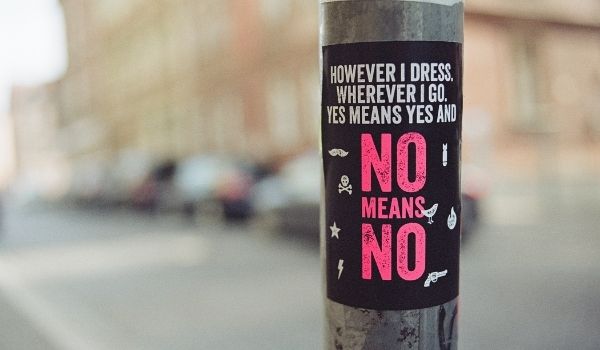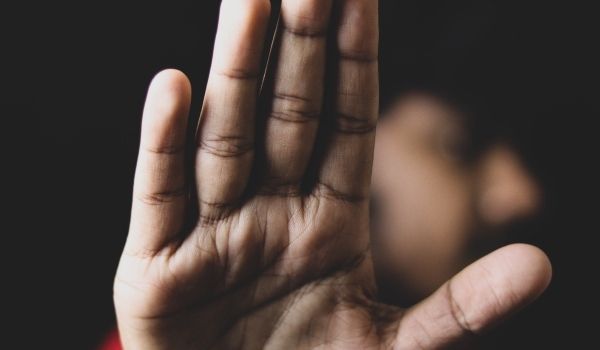You are returning through Amsterdam center late at night. As you enter Damrak, a busy high street and a known hangout for young men, you feel a tingle of fear. You grasp your keys firmly in your hand and speed up your pace.
“Hey, schatje…”
You keep walking ahead flustered, intimidated.
“Ho!” — the abusive words echo behind you…

Sadly, in the past year, 47% of women and 28% of men have encountered some form of street harassment. For women aged 15 to 24, these figures reach a shocking 74%. That’s only a slight decrease from last year, despite the attempts made by the Dutch authorities. Similar figures stand for members of the LGTBQ+ community. Here, 50% admit to avoiding public spaces to protect themselves from abuse based on their orientation. Another vulnerable group is citizens of ethnic backgrounds. Since the horrendous murder of 33-year old British Sarah Everard, the topic of street harassment has been drawn back into the spotlight. The news hit the world by storm, especially since the crime had taken place in one of London’s neater neighborhoods. No one would’ve expected such a horrendous crime would take place there. Sarah was a healthy young woman. She had been wearing sports clothing on the evening she was attacked. Still, she didn’t manage to escape the assaulter, who shockingly turned out to be a Metropolitan Police constable. The incident caused a worldwide uproar, taking thousands of protestors to the streets, calling for the right to feel safe in public spaces.
Comparably to the earlier #metoo campaign — the hashtags #saraheverard flooded social media, together with posts with slogans: “text me when you’re home.” While #metoo was related to assaults occurring behind closed doors, this movement was about guaranteeing safety for everyone outside of their home.
Over the past years, the Dutch authorities stepped up their game in fighting sexual harassment. Campaigns, such as You Are not Alone (Jij staat niet alleen), were rolled out in Amsterdam and Pikpraat in The Hague and Rotterdam. According to research, 2 out of 5 Amsterdam citizens admit to having encountered some form of intimidation on the streets, in nightclubs, or other public spaces. Forms of harassment include catcalling, hissing, inappropriate remarks, or even cornering on the street.
Victims of street harassment are often left feeling humiliated and helpless—especially subtler cases of assault. Many victims admit to not contacting the authorities in fear of being ridiculed. The interpretation of verbal comments can be a subjective matter, and frequently, the court has been classifying them under “freedom of expression” paragraphs. Even in situations that led to actual physical violence or rape, the public blamed victims for “being out so late at night” or for “dressing inappropriately.” This caused only 5% out of 84% of harassed women to report such cases to the authorities.
Not long ago, the municipalities of Rotterdam and Amsterdam introduced a ban on hissing, calling, or making obscene gestures to strangers. Breaking this law resulted in a substantial fine reaching 4,100 EUR or even three months in prison. The government had hoped to reduce the frequency of street harassment in public spaces. Yet, in 2018 a man accused of harassing two women by sexually addressing them and blowing hand kisses was let off the hook. The judges were unable to prove his behavior was more than an inadequate attempt to flirt. It turned out that the new anti-harassment laws conflicted with freedom of speech. This incident brought the topic of street harassment back into the spotlight.

What is Classified as Harassment?
Undesired comments, gestures, and actions forced upon a stranger in a public space without their consent directed at them because of their actual or perceived sex, gender, gender expression, or sexual orientation. Any behavior or speech continued towards a stranger, despite their request to stop, is considered harassment.
As a woman in her 30s and a psychologist, it took me until this year to realize how much I had adapted to living in fear. When returning home at night, I keep my gaze glued to the ground to avoid contact with strangers. I do the same when walking by football fields or construction sites, even in broad daylight. I don’t dare cycle through a park after midnight — instead, I’m forced to take the longer, well-lit route through the city. What’s most bizarre is that I have treated these measures as a norm for most of my life.
I decided to investigate the subject closer and created a questionnaire on a few social media pages. I inquired about people’s experiences with street harassment. There was a strong polarity in responses: half of the interviewees claimed they felt safer in the Netherlands than in their homeland, and the other half shared nerve-wracking stories of being assaulted in dark streets, bars, as well as in busy public spaces in broad daylight. There was also a handful of people (men) who responded to the subject with mockery (“No one has harassed me yet” or “missing the sexual harassment”). This highlighted the need to educate people on the severity of sexual harassment.
“I had a couple of experiences when I first arrived in Amsterdam. At some point, it was every morning at 6-ish when going to work with the streets being empty. Some street cleaners would catcall me (making kissing noises). I remember they were super persistent, sometimes following me with their tiny white truck. One morning, one of them came closer. I sent him to hell with one look, and he backed off, but after that, I started leaving to work later because it just didn’t feel safe.” – Aida
“A man followed me on a scooter. I ran to a football club close by and hid until he went away.” – Nadine
“Once, at the bar, this guy kept running his arm ‘accidentally ‘ against my breast. I had to keep my arm in place as a shield. Realized it was intentional when he grabbed my cigarette out of my hand and threw it in some water.” – Skye
“I was sitting in a train, and a drunk guy sat next to me. He started making sexual remarks to me, slapped my leg a couple of times, and then ran his hand up the inside of my thigh. Two women opposite of me cheered him on.” – Bert
“Once, I was cycling and got slapped quite hard on my ass while overtaking a man on a scooter.” – Ewa
We mustn’t confuse insults with compliments. It’s best to follow our intuition: we can pick up the caller’s intentions by their tone and body language. Luckily, there is a big difference between an attempt to flirt and an intimidating remark. Of course, grey areas exist where we can’t be entirely sure. There, it’s important to state your disapproval if you feel uncomfortable, and if the perpetrator doesn’t stop — take further action.

How to React to Street Harassment?
Most of all, do not take the blame on yourself. No one deserves to be mistreated regardless of gender, appearance, or ethnicity. Take action and prevent criminals from harming others in the future.
1) If you feel threatened: don’t react. Keep walking away with confidence. Next, call the police on 112 or anonymously report the location via your StopApp (active in Amsterdam, The Hague, and Rotterdam). You can download this app on your phone.
(Fact: 1400 reports were made in the first six months since its launch!)
If you incur violence, knowing these moves off by heart can help: 5 Simple Self-Defense Moves Every Woman Should Know | Prevention
You might also decide to buy a small can of pepper spray to feel safe. Feel reassured, though: the chances are minimal that you will ever have to use it.
2) Confidently address the harassing behavior. If others are around, be sure to describe the person who is crossing your boundaries. Some useful comments are:
- “Do not talk like that to me. That’s harassment!”
- “Stop touching my leg, man in orange shirt — that’s harassment!”
- “Move away from me.”
- “Show some respect.”
NEVER apologize for the way you feel. Responses such as “I’m sorry, but you are crossing my boundaries” will be less impactful.
Use assertive body language, project confidence, and remain calm. Try to avoid using curse words, even if your perpetrator is swearing.
Next, report the case to the police or via the app. Use your intuition here, and remember: you have the right to notify the authorities about anyone who makes you feel threatened and unsafe.
So, there you have it: the current review of street harassment in the Netherlands. As a psychologist, I advocate living with a fear-free mindset and knowing how to behave if you find yourself in an unsettling situation. As a Danish saying goes: “the greater the fear, the nearer the danger,” and there’s a certain truth in it.
Unfortunately, street harassment is a real problem, and it’s a relief that Dutch authorities are finally taking action. One of the key obstacles they will need to overcome is defining the difference between harassment and freedom of speech in the constitution. Meanwhile, we need to take action as a society by reporting such crimes to the police and speaking out when we witness harassment on the streets. Together we can bring on change.
Written by Michelle Prygiel, Psychologist
